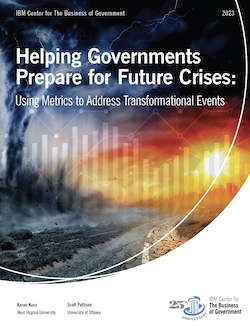
Using future recovery funds to help deliver key services during critical times of need.

Of the numerous bills that distributed funds to individuals, businesses and government entities, only the Coronavirus State and local Recovery Funds (CSLFRF) allocations came with mandated state reporting requirements. The creation and inclusion of performance metrics in required annual reports to the federal government is commendable However, the limited scope for which metrics were required, and lack of guidance for design of measures, resulted in information that was not sufficiently comprehensive nor comparable.
To address this challenge, this report explores how states distributed CSLFRF allocations and the metrics they developed to measure that spending as reported to the U.S. Treasury in required annual filings. An overview of all 50 states frame a more in-depth examination of three representative states with varied landscapes—Colorado, Florida, and Illinois—as case studies.
This research points to a finding that without definitive guidance on how to construct and employ performance measures, methods and effectiveness vary widely across states. The report applies common assessment criteria (i e , administration and distribution of funds, creation of performance measures, determination of effectiveness, and alignment with agency/program objectives) to the three case study states, and explores other ways in which federal funds transfers are tracked and measured.
The report developed several recommendations for state and federal government to effectively track and integrate spending into annual budget processes, in preparation for future transformational events. These recommendations include:
- Create measures that are useful and used.
- Integrate metrics and analytics into annual budget process.
- Keep measures simple and connected to goals.
- Build capacity.
- Develop incentives for states.
The authors’ work complements our Center’s ongoing initiative to develop research to help governments in preparing for and responding to “future shocks”—systemic crises including health events as well as cyber incidents, climate changes, supply chain disruptions, and workforce shortages. The future shocks initiative includes numerous reports and related publications, issued in collaboration with the National Academy of Public Administration, IBM Institute for Business Value, and other partners.
This report also continues the Center’s longstanding research and recommendations around using performance information to improve government operations.
We hope that state and federal leaders and stakeholders find this report helpful in developing strategies to address increasingly common transformational crises.



